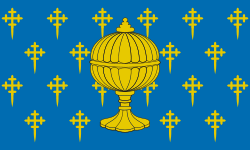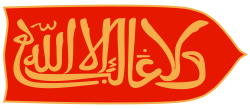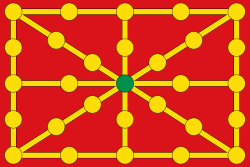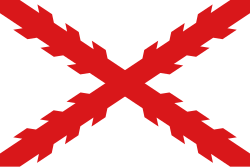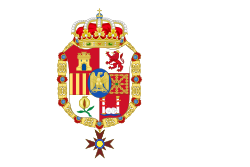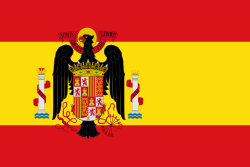| Flag | Date | Use | Description |
|---|
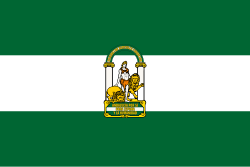 | | Flag of Andalusia (the Arbonaida) | Three equal horizontal bands of green (top), white and green, there is an Andalucian coat of arms in center of the white band. |
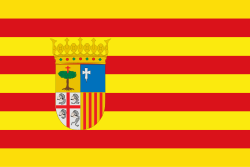 | | Flag of Aragon | Nine equal horizontal stripes of yellow (top, double width) and red, there is an Aragon coat of arms in left the red and yellow bands, the coat of arms featured a gold crown have four green small diamonds and three red small disk, the shield means four corner, first corner means (yellow field with a red cross in upper tree), second corner means (violet field with white cross in hoist-side left corner, third corner means (red St. George and St. Andrew cross have four corners have four man heads) and fourth corner means (nine equal vertical bands of yellow (top, double width) and red). |
 | | Flag of Asturias | Blue field with the Victory Cross in center, hanging from the horizontal axis on either side of the cross are an upper-case Greek letter Alpha (Α) on the left and a lower-case Omega (ω) on the right. |
 | | Flag of the Balearic Islands | Nine equal horizontal stripes of yellow (top, double width), and red, and a Balearic castle in purple hoist-side upper left corner. |
 | | Flag of the Basque Country (the Ikurriña) | The red ground symbolizes Biscayan people (the race); the green saltire represents the Oak of Guernica, a symbol of the old Basque laws, or Fueros; and the white cross over them as a symbol of Basque Catholic devotion. |
 | | Flag of the Canary Islands | Three equal vertical bands of white (top), blue, and yellow, there is a Canary Island coat of arms in center the blue band, the coat of arms featured the word motto "OCEANO" in silver ribbon in upper, royal crown in middle and two dogs are holding the shield in lower, the shield have seven hillocks. |
 | | Flag of Cantabria | Two horizontal stripes of equal width, white on the top and red on the bottom, and the region's coat of arms in its centre. The first field of the coat of arms represents the conquest of Seville by Cantabrian marines in 1248 (with the ship breaking the chains that blocked the way through the river Guadalquivir), while the second field honors the pre-Roman Cantabri people showing geometric ornaments typically found on Cantabrian stelae. [2] |
 | | Flag of Castilla-La Mancha | |
 | | Flag of Castile and León | Two Lions from the Kingdom of León and two castles from Kingdom of Castille. |
 | | Flag of Catalonia (the Senyera) | |
 | | Flag of Ceuta | |
 | | Flag of Extremadura | |
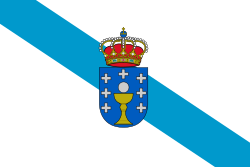 | | Flag of Galicia | |
 | | Flag of La Rioja | |
| | | Flag of Madrid | A crimson red field representing Castille, with seven five-pointed stars in silver (placed four and three in the centre) representing the administrative areas of the region. [3] |
 | | Flag of Melilla | |
 | | Flag of Murcia | |
 | | Flag of Navarre | Against a red background, the coat of arms of Navarre, which consists of a pattern of golden chains, with eight of them linked with an emerald in the center (based on the banner of the Ancient Kingdom of Navarre) |
| | | Flag of the Valencian Community (the Reial Senyera) | A derivation of the traditional Senyera of the Crown of Aragon, it is composed of four red bars on a yellow background, crowned with a blue strip party per pale next to the hoist. |































































































